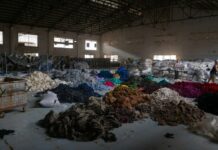The United States has enacted a universal 10% tariff on all imports effective April 5, 2025. This measure, along with specific tariffs starting April 9, is expected to significantly alter trade dynamics, especially impacting countries that heavily export textiles. The newly introduced reciprocal tariffs will greatly influence trade relations, pricing structures, and market competitiveness, particularly for nations with substantial textile exports to the US. Below is an analysis of the tariff adjustments for some of the leading textile-exporting countries and the potential implications for their industries, reflecting the US tariff impact on textile exporting countries.
India
India, a key player in textile exports, will face a dramatic tariff increase from 4.57% to 30.57%, a staggering 669% rise. This escalation could put immense cost pressure on Indian textile exports, making them less competitive in the US market. In 2024, India exported $2,768.75 million worth of textiles to the US, and this increase may force American buyers to look for alternatives with more favorable tariffs, highlighting the US tariff impact on textile exporting countries.
The textile industry is essential to India’s economy, contributing about 2.3% to the national GDP and serving as the second-largest employment sector after agriculture. India has a wealth of raw materials, especially cotton, which it exports to major global markets, including the US.
Although the new tariffs may be less burdensome for India compared to those imposed on China, they could still lead to significant local disruptions, including job losses in the sector. However, India might better withstand these changes due to lower tariff rates relative to China and the ongoing reliance of the US on critical Indian raw materials like cotton.
Additionally, India’s favorable trade position could attract foreign investment as global companies seek to diversify their sourcing. This shift may lead to increased foreign direct investment (FDI) in Indian textiles, helping to alleviate some immediate challenges posed by the tariff hike, which underlines the broader implications of the US tariff impact on textile exporting countries.
China
China, one of the largest textile exporters worldwide, is facing a drastic tariff increase from 4.4% to 38.4%, an astounding 873% rise. This hike will significantly elevate costs for Chinese textile exports to the US, compelling American importers to find alternative sourcing options. Such a shift could endanger China’s long-standing dominance in the US textile market. In 2024, China exported textiles worth $2,541.07 million to the US, putting that trade at risk due to the tariff surge.
The US has made its strategic objectives clear by targeting China’s export-driven economy at its most sensitive points. China’s competitive advantage in textiles, historically based on low costs, will be severely weakened by these steep tariffs. The US tariff impact on textile exporting countries will be felt acutely in China as it navigates these challenges.
With China’s vast production capacity, there is a high likelihood of oversupply, leading to potential dumping in other markets, particularly in least developed countries (LDCs) in Central Asia and Africa.
Turkiye
Turkiye’s textile exports to the US will see a moderate tariff increase from 4.92% to 14.92%, a 303% rise. Despite this increase, Turkiye might maintain its competitive edge in the US market, particularly in high-value textile segments. In 2024, Turkiye exported textiles worth $620.31 million to the US, and this new tariff could offer an opportunity for Turkiye to expand its market share as competitors face larger tariff hikes.
Turkiye is known for its high-quality textiles, which perform well in the EU market due to geographic proximity and solid trade ties. While its presence in the US has historically been more limited, the relatively modest tariff increase could enable Turkish exporters to strengthen their foothold in the American market as US buyers look to diversify away from China and Vietnam.
Conclusion
The introduction of a universal 10% tariff on imports, coupled with steep country-specific increases, is poised to reshape the global textile trade landscape. Countries like Vietnam and China, facing significant tariff hikes, may see a decline in their competitiveness in the US market. This shift underscores the US tariff impact on textile exporting countries as nations adapt to these new realities.
Conversely, nations like Mexico and Canada could maintain a competitive advantage due to protective agreements, providing some stability amid the broader disruption. Smaller economies like Pakistan and Taiwan may struggle to absorb increased costs, losing ground to more favorably positioned competitors. Meanwhile, European exporters like Turkiye and Germany may find new opportunities in higher-value segments where price sensitivity is lower.
Ultimately, the evolving tariff landscape will force exporting nations to reassess their strategies—diversifying markets, investing in value addition, or negotiating new trade agreements. These shifts are likely to drive long-term changes in global textile trade patterns, creating both challenges and opportunities in an increasingly protectionist environment, all of which illustrate the critical US tariff impact on textile exporting countries.
































